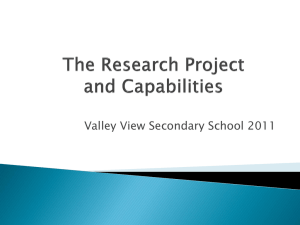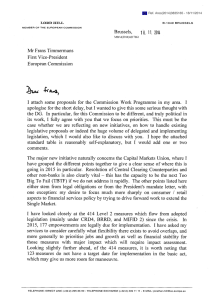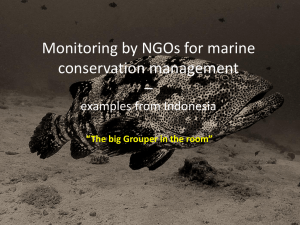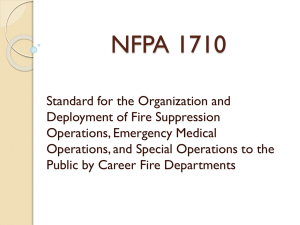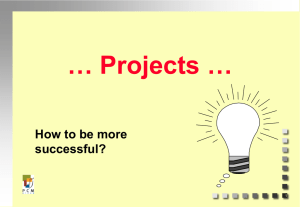Concept note presentation - Participatory Development Programme
advertisement
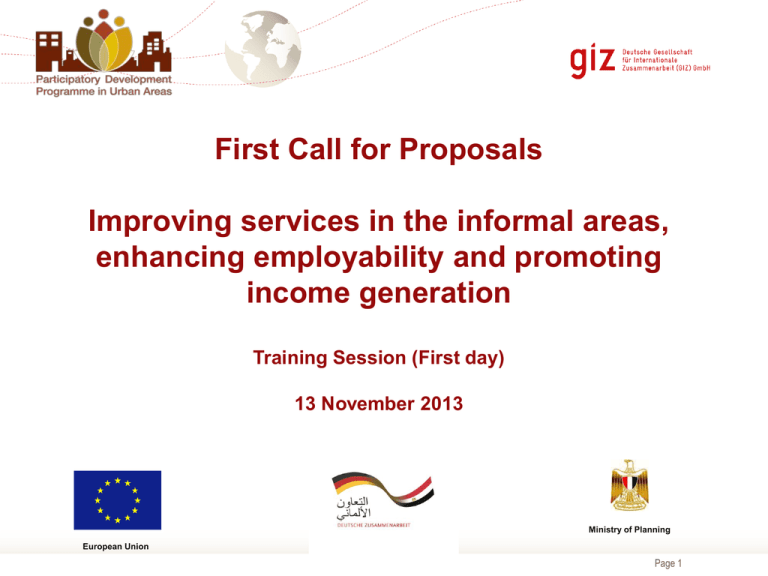
First Call for Proposals Improving services in the informal areas, enhancing employability and promoting income generation Training Session (First day) 13 November 2013 Ministry of Planning European Union Page 1 Concept Note 2 Page 2 AGENDA 3 • How to develop a Concept Note • How to Apply Page 3 General Comments 4 Page 4 Does not exceed 5 full pages (A4 size) of Arial 10 characters with 2 cm margins, single line spacing; Typed and written in ENGLISH Only the CN will be evaluated so it is of UTMOST IMPORTANCE that all the important elements regarding the action are contained therein Please follow the template in PART A of the Application Form Page 5 Concept Note • provides the information requested under the headings below, in the order in which it is requested, and in proportion to its relative importance (see the relevant scores set out in the evaluation grid and in the Guidelines); • provides full information (as the evaluation grid will be applied solely on the information in the concept note); • is drafted as clearly as possible to enable it to be evaluated. 6 Page 6 sections Concept Note 7 Page 7 1. SUMMARY OF THE ACTION (Max 1 page) 8 Page 8 Title of the action: [Lot: - Please tick the box corresponding to the specific lot for which you are applying:: X Y Location(s) of the action: — specify country(ies), region(s) that will benefit from the action Total duration of the action (months): EU financing requested (amount) EU financing requested as a percentage of total budget of the Action (indicative) Objectives of the action <EUR / currency of the Contracting Authority > % <Overall objective(s)> <Specific objective(s)> Target group(s) Final beneficiaries Estimated results Main 9 activities Page 9 1. SUMMARY OF THE ACTION (MAX 1 PAGE) • • • • • • • • • • 10 Title of the action and Lot Number Location Total duration of the action EU financing requested EU financing requested as a percentage of total budget of the Action (indicative) Objectives of the action Target group(s) Final beneficiaries Estimated results Main activities Page 10 Title of the Project • This is not an important section; nevertheless, your title should be brief, clear and interesting and unambiguous (Do not make it "cute"). • Think of your title as a mini-abstract. A good title should paint a quick picture for the reader of the key idea(s) of your project. • The words you use in your title should clearly reflect the focus of your proposal. • The most important words should come first, then the less important words. Notice that both of the following titles use basically the same words, except in a different order. The project with Title Number 1 appears to be focused on women. The project with Title Number 2 appears to be focused on the promotion of self-employment. However, both projects are the same! Make sure your words are in the correct order and clearly reflect what your project is about. Title 1 Women and the Promotion of Self-Employment Title 2 Promoting Self-Employment among women 11 Page 11 Location of the action In this section you describe the region in which the project will be implemented and which will benefit from the project. It is important to be realistic when deciding the number and /or size of the region(s). Duration of the action In months and make sure your stated duration is in conformity with that stated in the Guidelines for Applicants. 12 Page 12 EU Financing requested (amount) Make sure that the amount requested for the particular lot is within the limits given in the Guidelines for Applicants and that it matches the figure given in the first column of the summary table at the front of the application form. Be absolutely sure that this does not exceed the maximum or minimum amounts or the maximum percentage (80%) specified in the Guidelines for Applicants. All the figures you insert in this table should correspond exactly to those you present in the Budget for the project and, in fact, these figures should only be inserted after you have completed the budget. 13 Page 13 Objectives of the Action The overall objective describes your project’s broad and long term objective in the wider policy context. It gives the answer to the question “Why is the project important? The overall objective states the overall development aim towards which your more specific project purpose should contribute. Overall objectives commonly begin with the following wording: “To make a contribution to….” 14 Page 14 Objectives of the Action Important things to remember about the overall objective are: •You cannot achieve the general objective or goal on your own as a project organisation. Your project will make a contribution towards achieving it. •The general objective or goal provides a benchmark against which the success of your project and that of others with a similar purpose can be measured. •The overall objective or goal should be compatible with your organisation’s mission statement and with the overall objective of call for proposals (Section 1.2 of the Guidelines for Applicants). 15 Page 15 The specific objective The specific objective is usually something that your project should be able to achieve through its work. It is an outcome that should be possible in the time specified, and it is the strategy the organization and the project believe will address a particular problem in a particular area, making a contribution to achieving the overall objective or goal. Remember a good specific objective usually states: •What you want to achieve (your ends) •How you want to achieve it (your means) •Who the final beneficiaries will be. 16 Page 16 Avoid these mistakes The overall objective of the project is not in line with the objective of the Grant Programme; The Project’s specific objective is unclear which makes it impossible for the evaluator to check for compliance between the objectives of the proposed project and those of the Grant Scheme Programme; Lack of coherence between the project objectives and the identified needs and problems; The project’s specific objective is unrealistic and not achievable during the lifetime of the project. The project’s specific objectives are formulated as activities (a very common mistake in the formulation of specific objectives). 17 Page 17 “Target groups” are the groups/entities who will be directly benefit from the action at the action purpose level. 18 “Final beneficiaries” are those who will benefit from the action in the long term at the level of the society or sector at large Page 18 Estimated results You need to be brief here but include all of the expected results you specified in the next section (Description of the Action, line 6). Main Activities List the main activities using the activities that you have listed at in the next section (Description of the Action, line 6). The activities you describe here should also correspond to those listed in the Action Plan at Section 2.1.3. 19 Page 19 The best time to prepare the Project Summary is after you have completed the entire project design and development (and you understand all aspects of your project very well). 20 Try to keep in mind that someone will be reviewing your proposal and you would like to have this person be very positive about what you have written. Page 20 The Project Summary will probably form a strong impression in the mind of the evaluator. Work on your Project Summary so that you can avoid giving this person the opportunity to say things like: • Not an original idea • Problem is not important • Rationale is weak •Results are vague and uncertain • Does not have relevant experience •Proposal is unfocused. 21 Page 21 2- DESCRIPTION OF THE ACTION (Max 1 page) 22 Page 22 1. DESCRIPTION OF THE ACTION (max 1 page) • Give the background to the preparation of the action. • Explain the objectives of the action • Describe the key stakeholder groups, their attitudes towards the action and any consultations held with them. • Briefly state the type of activities proposed and specify related outputs and results, including a description of linkages/relationships between activity clusters. • State the broad timeframe for the action and describe any specific factor that has been taken into account. 23 Page 23 •Give the background to the preparation of the Action •Explain here how you went about preparing the project. • Was the project developed by an individual or by a by a committee or panel with one person doing the writing of the proposal. •Detail other organisations involved in the development process and describe the number of meetings held to discuss project design, etc. • Projects should not be developed without consultation with key stakeholders and representatives of the target group(s). 24 Page 24 Explain the objectives of the action given in the table in Section 1.1. Elaborate here on the objectives referred to in the table in section 1.1 above taking into account the advice given on formulating and writing objectives in section 1.1. 25 Page 25 Describe the key stakeholder groups, their attitudes towards the action and any consultations held with them. Good practice requires the project to be based on consultations with the target groups – surveys, interviews, focus groups, etc. Therefore, in this section explain in what ways you have already had contact with the target group, in what ways have members of the target group been involved in the preparation of the proposal and show that you have the support of the target group to move ahead with the project. If, in the project preparation stage you conducted a special needs assessment survey or have tested the project methods, do not forget to attach a short report on the survey in your proposal 26 Page 26 Briefly states the types of activities proposed and specify related outputs and results, including a description of linkages/relationships between activity clusters. In this section you need to describe what the project will do (the activities) in order to deliver its intended objectives. Only describe those activities that lead to concrete results. Provide a title and brief description of each activity to be undertaken to produce the results you specified in the table in 1.1, specifying, in particular, the role of co-applicant(s) (or associates and/or affiliates) in the implementation of activities and related results / outputs. 27 Page 27 State the broad timeframe for the action and describe any specific factor that has been taken into account. Your description of activities should be sufficiently detailed to allow evaluators and monitoring officers to understand exactly what you are intending to do and also to allow them to make an assessment of the costs you have allocated to each activity. The description of each activity should be detailed and specific and should give an answer to the following questions: What? How? How many? Where? Who? How long? When? 28 Page 28 Major mistakes in describing Activities •No compliance between activities, results, objectives; •Too many activities; •Including activities which do not lead to achievement of project purpose; •Some of the activities overlap with responsibilities and activities of central/local administration; •Activities are not clearly described and in sufficient details. 29 Page 29 3. RELEVANCE OF THE ACTION (Max 3 page) 30 POINTS 30 Page 30 RELEVANCE OF THE ACTION 1.1.1 Relevance to the objectives/sectors/th emes/specific priorities of the call for proposals 31 1.1.3. Describe and define the target groups and final beneficiaries, their needs and constraints and how the action will address these needs 1.1.2 Relevance to the particular needs and constraints of the target country/countries, region (s) and/or relevant sectors (including synergy with other EU initiatives and avoidance of duplication) 1.1.4. Particular addedvalue elements Page 31 1.1.1 Relevance to the objectives/sectors/themes /specific priorities of the call for proposals Describe the relevance of the action to the objective(s) and priority (ies) of the call for proposals. It is absolutely imperative that the overall and specific objectives of your project are very close and in compliance with the overall and specific objectives and priorities of the current call for proposals and you should clearly identify these from the guidelines for Applicants in respect of the call for proposals. 32 Page 32 1.1.1 Relevance to the objectives/sectors/theme s/specific priorities of the call for proposals Describe the relevance of the action to any specific subthemes/sectors/areas and any other specific requirements stated in the Guidelines for the call, e.g., local ownership etc. This will not be the case for all calls and if the call you are addressing does not then do not write anything under this question. However, certain calls for proposals there will be a reference to sub-themes/sectors/areas. If that is the case, make it clear how your proposed project addresses these requirements. 33 Page 33 1.1.1 Relevance to the objectives/sectors/them es/specific priorities of the call for proposals Describe which particular expected results referred to in the Guidelines for the call will be addressed. Calls for proposals will also specify that the programme under which the call is funded is designed to achieve certain results. If this is the case, then try and demonstrate how your project will make a contribution to that result. This will not be the case for all calls and if the call you are addressing does not then do not write anything under this question. 34 Page 34 1.1.1 Relevance to the objectives/sectors/themes/specif ic priorities of the call for proposals Describe/highlight eventual changes of the information provided in the concept note (this only applies in the case of a restricted call for proposals) It is important that you clearly identify anything that has changed in the concept note in relation to your project design or budget 35 Page 35 1.1.2 Relevance to the particular needs and constraints of the target country/countries, region (s) and/or relevant sectors (including synergy with other EU initiatives and avoidance of duplication) State clearly the specific pre-project situation in the target country/countries, region(s) and/or sectors (include quantified data analysis where possible). In order to complete this section you will need access to basic statistics on the situation at both local and, if possible municipal/district and national level. However, in the context of your project, the situation at the level which your project plans to address is the most important 36 Page 36 1.1.2 Relevance to the particular needs and constraints of the target country/countries, region (s) and/or relevant sectors (including synergy with other EU initiatives and avoidance of duplication) Provide a detailed analysis of the problems to be addressed by the action and how they are interrelated at all levels. In this sub-section provide a clear statement of the problem to show that your proposed project is definitely needed and should be funded. You should give an analysis of the target region / target groups answering the following questions: What are the main problems affecting the target group or target region? What are the causes of the problems? What are the effects of the problems? What are the possible solutions? 37 Page 37 1.1.2 Relevance to the particular needs and constraints of the target country/countries, region (s) and/or relevant sectors (including synergy with other EU initiatives and avoidance of duplication) In addressing the point above, refer to any significant plans undertaken at national, regional and/or local level relevant for the action and describe how the action will relate to such plans. Here you should concentrate on the pre-project situation in your region/district/municipality and check if there are existing strategies which relate to the issue being addressed by your project and / or the call for proposals. If such strategies exist then explain how your project will contribute to the implementation of that strategy. If no such strategies exist, make this clear in your answer. 38 Page 38 1.1.2 Relevance to the particular needs and constraints of the target country/countries, region (s) and/or relevant sectors (including synergy with other EU initiatives and avoidance of duplication) Where the action is the continuation of a previous action clearly indicate how the proposed action is intended to build on the activities/ results of this previous action; refer to main conclusions and recommendations of evaluations that might have been carried out. 39 Page 39 1.1.3. Describe and define the target groups and final beneficiaries, their needs and constraints and how the action will address these needs Identify the needs and constraints of each of the target groups and final beneficiaries. Explain any participatory process ensuring participation by the target groups and final beneficiaries. 40 Give a description of each of the target groups and final beneficiaries (quantified where possible), including selection criteria. Demonstrate the relevance of the proposal to the needs and constraints of the target groups and final beneficiaries. Page 40 Major Mistakes in Writing Section 1.1.3 Analysis of the problems and needs of the target region and group (s) is inadequate – superficial, not based on reliable data sources, etc. Project does not address the most pressing needs of the target groups; Target groups not clearly identified or too broad; Target groups are ineligible. No proof that the target groups and beneficiaries are aware of the project idea and have expressed expectations / perceptions, i.e. no evidence of activities conducted to ensure participation. 41 Page 41 1.1.4. Particular addedvalue elements In this section you are asked to indicate any added value elements value elements, in particular any specific added-value elements, e.g. the promotion or consolidation of public-private partnerships, innovation and best practice, or other cross-cutting issues such as environmental issues, promotion of gender equality and equal opportunities, the needs of disabled people, the rights of minorities and the rights of indigenous peoples. These could be: Implementation of new effective approaches to a certain problem; Application of good practice models from other regions or countries; Promotion of gender equality; Promotion of equal opportunities for people with disabilities 42 Page 42 Scores Concept Note – Evaluation Grid 1. Relevance of the action (6) 1.1 How relevant is the proposal to the objectives and priorities of the Call for Proposals?* Sub-score 5x2* 1.2 How relevant to the particular needs and constraints of the target region(s) is the proposal (including synergy with other EU initiatives and avoidance of duplication)? 5x2 1.3 How clearly defined and strategically chosen are those involved (final beneficiaries, target groups)? Have their needs been clearly defined and does the proposal address them appropriately? 5 1.4 Does the proposal contain specific added-value elements, such as environmental issues (climate change), promotion of gender equality and equal opportunities (particularly women and youth), needs of disabled people, rights of minorities and rights of indigenous peoples, or innovation and best practices 5 2. Design of the action Sub-score 2.1 How coherent is the overall design of the action? In particular, does it reflect the analysis of the problems involved take into account external factors and relevant stakeholders? 5x2* 2.2 Is the action feasible and consistent in relation to the objectives and expected results? 5x2* TOTAL SCORE 43 30 20 50 Page 43 How to apply Applicants prepare an envelope including: • Concept Note - one original + 2 copies + electronic version on CD-Rom • Checklist – one original completed • Applicant declaration – one original completed and signed 44 Page 44 How to apply The outer envelope must show: the reference number and the title of the call for proposals the full name and address of the applicant the words "Not to be opened before the opening session" and " ال ”تفتح قبل جلسة فتح المظاريف Concept Notes must be submitted in a sealed envelope by: registered mail private courier service hand-delivery • Address: GIZ Participatory Development Programme 12 Saleh Ayoub Str., 5th floor, app. 12 11211 Zamalek, Cairo 45 Page 45 Questions • Questions about the Calls may be sent by e-mail to: grant.queries@gizeg.com • Deadline to submit questions: 15 December 2013 • GIZ has no obligation to provide further clarifications after this date. • Replies to Frequently Asked Questions (FAQ) will be published on: https://webgate.ec.europa.eu/europeaid/onlineservices/index.cfm?do=publi.welcome 46 Page 46 Final Tips • Read the Guidelines very carefully: ALL THE INFORMATION PRESENTED TODAY IS THERE!!! • Read the Application Form (Annex A) very carefully • Read the General Conditions of the draft contract very carefully • Check the EuropeAid and GIZ websites regularly for updates on Frequently Asked Questions, corrigenda, or modifications to the calendar • Ensure that your contact details are up to date to facilitate correspondence • Use the checklist for Concept Note to ensure that you meet all the administrative requirements • GIZ cannot advise on the eligibility of applicants, partners or actions 47 Page 47



